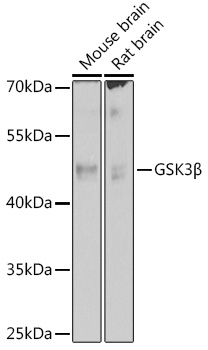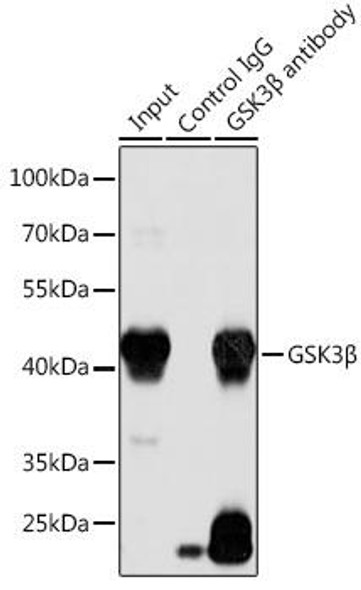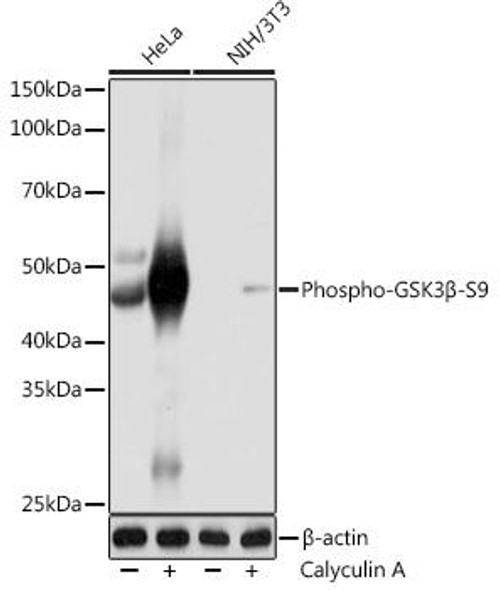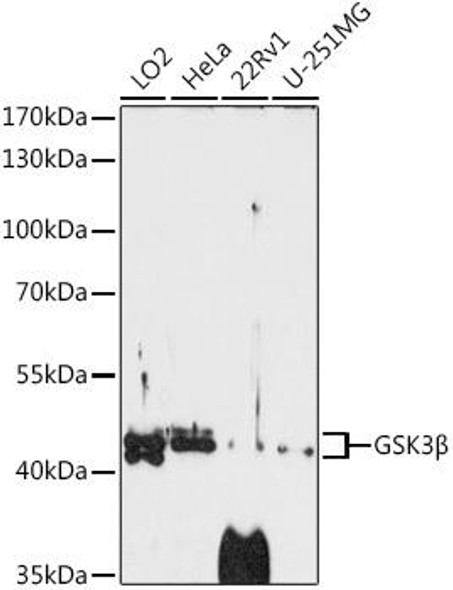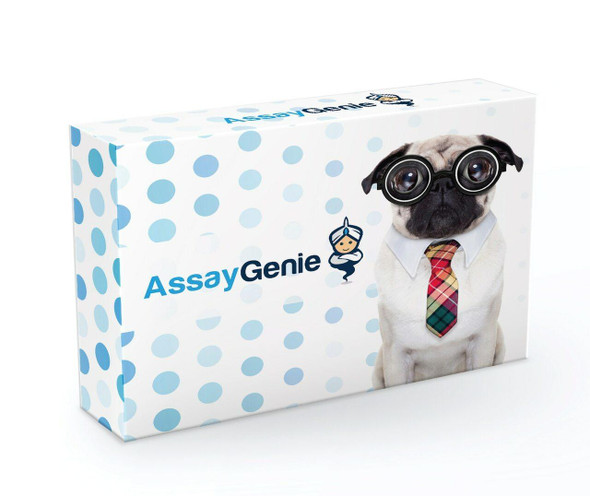Anti-GSK3Beta Antibody (CAB11360)
- SKU:
- CAB11360
- Product Type:
- Antibody
- Reactivity:
- Human
- Mouse
- Rat
- Host Species:
- Rabbit
- Isotype:
- IgG
- Antibody Type:
- Polyclonal Antibody
- Research Area:
- Cell Biology
Description
Anti-GSK3Beta Antibody (CAB11360)
The GSK3B Polyclonal Antibody (CAB11360) is a valuable tool for researchers studying GSK3B, a key enzyme involved in cellular signaling pathways and regulation of various cellular processes. This antibody is raised in rabbits and is highly specific for human samples, making it ideal for use in Western blot applications to detect and analyze GSK3B protein levels in different cell types.GSK3B, also known as glycogen synthase kinase 3 beta, is an important regulator of diverse biological functions like cell proliferation, differentiation, and apoptosis. Dysregulation of GSK3B has been implicated in various diseases, including cancer, neurodegenerative disorders, and diabetes.
Therefore, studying the expression and activity of GSK3B is crucial for understanding its role in these pathologies and developing targeted therapies.By using the GSK3B Polyclonal Antibody, researchers can accurately assess GSK3B levels in cell lysates or tissue samples, providing valuable insights into the molecular mechanisms underlying disease processes. This antibody's high specificity and sensitivity make it a reliable tool for investigating GSK3B function and potential therapeutic interventions.
| Antibody Name: | Anti-GSK3Beta Antibody |
| Antibody SKU: | CAB11360 |
| Antibody Size: | 20uL, 50uL, 100uL |
| Application: | WB IHC IF |
| Reactivity: | Human, Mouse, Rat |
| Host Species: | Rabbit |
| Immunogen: | A synthetic peptide corresponding to a sequence within amino acids 320 to the C-terminus of human GSK3Beta (NP_001139628.1). |
| Application: | WB IHC IF |
| Recommended Dilution: | WB 1:200 - 1:500 IHC 1:50 - 1:200 IF 1:50 - 1:200 |
| Reactivity: | Human, Mouse, Rat |
| Positive Samples: | Mouse brain, Rat brain |
| Immunogen: | A synthetic peptide corresponding to a sequence within amino acids 320 to the C-terminus of human GSK3Beta (NP_001139628.1). |
| Purification Method: | Affinity purification |
| Storage Buffer: | Store at -20'C. Avoid freeze / thaw cycles. Buffer: PBS with 0.02% sodium azide, 50% glycerol, pH7.3. |
| Isotype: | IgG |
| Sequence: | LLEY TPTA RLTP LEAC AHSF FDEL RDPN VKLP NGRD TPAL FNFT TQEL SSNP PLAT ILIP PHAR IQAA ASTP TNAT AASD ANTG DRGQ TNNA ASAS ASNS T |
| Gene ID: | 2932 |
| Uniprot: | P49841 |
| Cellular Location: | Cell membrane, Cytoplasm, Nucleus |
| Calculated MW: | 46kDa/48kDa |
| Observed MW: | 46kDa |
| Synonyms: | GSK3B, gsk-3Beta |
| Background: | The protein encoded by this gene is a serine-threonine kinase, belonging to the glycogen synthase kinase subfamily. It is involved in energy metabolism, neuronal cell development, and body pattern formation. Polymorphisms in this gene have been implicated in modifying risk of Parkinson disease, and studies in mice show that overexpression of this gene may be relevant to the pathogenesis of Alzheimer disease. Alternatively spliced transcript variants encoding different isoforms have been found for this gene. |
| UniProt Protein Function: | GSK3B: a proline-directed protein kinase of the GSK family. Phosphorylates and inactivates glycogen synthase. Participates in the Wnt signaling pathway. Involved in energy metabolism, neuronal cell development, and body pattern formation |
| UniProt Protein Details: | Protein type:Protein kinase, CMGC; EC 2.7.11.26; EC 2.7.11.1; Protein kinase, Ser/Thr (non-receptor); Kinase, protein; CMGC group; GSK family; GSK subfamily Chromosomal Location of Human Ortholog: 3q13.3 Cellular Component: axon; beta-catenin destruction complex; cell soma; centrosome; cytoplasm; cytosol; dendritic shaft; dendritic spine; growth cone; lipid raft; mitochondrion; nucleus; perinuclear region of cytoplasm; plasma membrane; ribonucleoprotein complex Molecular Function:ATP binding; beta-catenin binding; integrin binding; ionotropic glutamate receptor binding; kinase activity; NF-kappaB binding; p53 binding; protein binding; protein kinase activity; protein kinase binding; protein serine/threonine kinase activity; tau protein binding; tau-protein kinase activity; ubiquitin protein ligase binding Biological Process: aging; axonogenesis; cell migration; circadian rhythm; dopamine receptor signaling pathway; epithelial to mesenchymal transition; ER overload response; establishment of cell polarity; fat cell differentiation; genetic imprinting; glycogen metabolic process; hippocampus development; myoblast fusion; negative regulation of apoptosis; negative regulation of dendrite morphogenesis; negative regulation of glycogen biosynthetic process; negative regulation of MAP kinase activity; negative regulation of neuron maturation; negative regulation of NFAT protein import into nucleus; negative regulation of nitric-oxide synthase activity; negative regulation of protein binding; negative regulation of protein complex assembly; organ morphogenesis; peptidyl-serine phosphorylation; peptidyl-threonine phosphorylation; positive regulation of axon extension; positive regulation of cell-matrix adhesion; positive regulation of GTPase activity; positive regulation of neuron apoptosis; positive regulation of peptidyl-serine phosphorylation; positive regulation of proteasomal ubiquitin-dependent protein catabolic process; positive regulation of protein binding; positive regulation of protein catabolic process; positive regulation of protein complex assembly; positive regulation of protein export from nucleus; positive regulation of smooth muscle cell proliferation; positive regulation of transcription from RNA polymerase II promoter; proteasomal ubiquitin-dependent protein catabolic process; protein amino acid autophosphorylation; protein amino acid phosphorylation; protein export from nucleus; re-entry into mitotic cell cycle; regulation of microtubule-based process; regulation of neuronal synaptic plasticity; response to activity; response to drug; response to estradiol stimulus; response to insulin stimulus; Wnt receptor signaling pathway; Wnt receptor signaling pathway through beta-catenin |
| NCBI Summary: | The protein encoded by this gene is a serine-threonine kinase, belonging to the glycogen synthase kinase subfamily. It is involved in energy metabolism, neuronal cell development, and body pattern formation. Polymorphisms in this gene have been implicated in modifying risk of Parkinson disease, and studies in mice show that overexpression of this gene may be relevant to the pathogenesis of Alzheimer disease. Alternatively spliced transcript variants encoding different isoforms have been found for this gene.[provided by RefSeq, Sep 2009] |
| UniProt Code: | P49841 |
| NCBI GenInfo Identifier: | 20455502 |
| NCBI Gene ID: | 2932 |
| NCBI Accession: | P49841.2 |
| UniProt Secondary Accession: | P49841,Q9BWH3, Q9UL47, D3DN89, |
| UniProt Related Accession: | P49841 |
| Molecular Weight: | 48,034 Da |
| NCBI Full Name: | Glycogen synthase kinase-3 beta |
| NCBI Synonym Full Names: | glycogen synthase kinase 3 beta |
| NCBI Official Symbol: | GSK3B |
| NCBI Protein Information: | glycogen synthase kinase-3 beta |
| UniProt Protein Name: | Glycogen synthase kinase-3 beta |
| UniProt Synonym Protein Names: | Serine/threonine-protein kinase GSK3B (EC:2.7.11.1) |
| Protein Family: | Glycogen synthase kinase |
| UniProt Gene Name: | GSK3B |
| UniProt Entry Name: | GSK3B_HUMAN |









